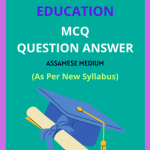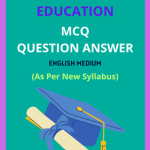Class 11 Education Chapter 5 Physical Basis of Mental Life Question Answer to each chapter is provided in the list so that you can easily browse throughout different chapters AHSEC Class 11 Education Chapter 5 Physical Basis of Mental Life and select need one.
Class 11 Education Chapter 5 Physical Basis of Mental Life
Also, you can read the AHSEC book online in these sections Solutions by Expert Teachers as per AHSEC (CBSE) Book guidelines. These solutions are part of AHSEC All Subject Solutions. Here we have given Assam Board/NCERT Class 11 Education Chapter 5 Physical Basis of Mental Life Solutions for All Subject, You can practice these here.
Physical Basis of Mental Life
Chapter: 5
EDUCATION
TEXTUAL QUESTION & ANSWER
Choose the correct alternative :
1. Among the different senses organs occupy the most dominant position.
(a) Ear. (b) Eye (c) Semicircular canals (d) Tongue
Ans: Eye
2. Light rays pass through to finally reach the retina
(a) Cornea (b) Pupil (c) Lens (d) All of the above
Ans: All of the above
3. Which sens origin is not associated with the collection of informations from within the body
(a) Kinesthetic (b) Vestibular (c) Taste (d) Vision
Ans: Taste
4. Human being posses sense organs
(a) 10 (b) 5 (c) 7 (d) 8
Ans: 10
Fill in the blanks with appropriate words.
1. The cell is called __ of life
Ans: Smallest unit.
2. The life is based upon the working of the __
Ans: Cell
3. The main structure of the neuron are _,__and __
Ans: Soma, dendrite, and axon.
4. The central nervous system consists of the _and_
Ans: Brain and spinal cord
Give the Answers
1. What do you mean by the central nervous system? Show in a diagram the main parts of the central nervous system
Ans: Man is a psycho – physical organism. The source of mind is the body. Mental processes and bodily activities are like two rails running parallel to each other. The central nervous system integrates our body into one unit. The central nervous system is formed by the brain and the spinal cord.

2. Show how the eyes are related to the central nervous system.
Ans: The eye is the receptor of sight through the eyes a person experiences light, color, shape and size. The structure of the eye is similar to that of the camera. The eye is stimulated by light. When light falls on an object, the retina is stimulated and this sensation is carried to the brain by the optic nerve. Through the cooperation of the eye, nerves and brain.
We see “The different parts of the eye are cornea, aqueous humour, iris, pupil, lens, ciliary muscles, vitreous humour, saluretic coat, choroid, retina, optic nerve, yellow spot and blind spot.
3. State the importance of receptions and effected.
Ans: The organs which help us to receive information about the external world are known as “Receptors or sense organs. They are also known as the gateway of knowledge. The receptors are of five types. Eyes for sight, ears for hearing, nose for smell, skin for touch and tongue for taste. Each sense organs cannot carry out the function of another receptors help in notification and discrimination of similar as well as dissimilar experiences.
For example, an elephant seen for the first time by an individual is a new experience but when it is seen the second time it is identified by the eyes. This is the same with all the other sense organs.
Effectors : Effectors are those parts of the body through which the behaviour of a person is completed. The effectors work after the body receives some kind of sensation. For example if a person sees a snake, he will somehow try to escape from it. This action is produced by the effectors.
4. Distinguish between illusion and hallucination.
Ans: (1) The object which creates illusion is present to sense. Hallucinations is created without the presence of any object.
(2) The brain’s functions normally when illusion appears.
On the other hand the brain functions abnormally in hallucinative
(3) In illusion the behaviour, movement and other things remain normal. But in hallucinations, the behaviour, manner and movement etc. turn abnormal.
(4) In illusion this exponent is common to everyone
On the other hand in hallucinations this experience is uncommon.
(5) In illusion, it’s influence is deep and extensive.
But in hallucinations it’s influence is temporary only.
5. Explain the meaning of perception and justify the need of sense training into the education of the children.
Ans: Perception is sensations plus meaning. It is an act of giving meaning to sensory experience. In case of perception the mind remains in an active state According to Ryburn. The process of interpretation of sensation according to experience is known as perception. It depends on our past experiences. Sensations is awareness of objects and perception is the awareness of this or that object.
For example we hear a sound. It is sensations Then it could be obtained because we have past experiences of hearing the sound of buzzing bees. This is perception.
Training in this sense is very essential for effective learning. It is very much essential for children who have some defect in their sense organs. Such children have to be separated from the normal ones. They need special care and training. Madame Montessori has emphasized on sense training. Sense training of the mind, of its ability to discriminate and interpret whatever the sense organs perceive.
Sense training also provides the children with a wider sensory experience of the world. Children can gather real life experience which they otherwise do not have in their day to day life. Mere reading of books cannot achieve anything without actual sensory experience. Teachers curd parents should therefore take children out as often as possible. School journeys and excursions will provide a concrete background for instruction and also help children to develop an interest in the outside world.
| Sl. No. | Contents |
| Chapter 1 | Concept and Aims of Education |
| Chapter 2 | Stages of Human Development |
| Chapter 3 | School and its Organizations |
| Chapter 4 (A) | Psychology and Education |
| Chapter 4 (B) | Education Psychology and its Significance |
| Chapter 5 | Physical Basis of Mental Life |
| Chapter 6 | Bases and Direction of Human Behaviour |
| Chapter 7 | Primary Education in India and Assam |
6. What is conception? Write five characteristics of conceptions?
Ans: Conception is the final stage of the knowing process. Knowledge of a particular thing is complete when we form the concept of the object in our minds. It is the name given to a class of objects depending on their common qualities. It is defined as a classification of stimuli that has common characteristics. A concept is thus a system of meaning.
It is the power to generalize objects. Perception refers to the meaning of an object while conception is naming of a class of objects on the basis of their qualities. It is therefore a much higher mental function that involves observation analysis observation, analysis abstraction, synthesis, comparison and naming of the perceptual experience. For example when we talk of birds the qualities of birds automatically comes to our mind be it a crow, cuckoo, mainah, sparrow etc.
Characteristics :
(1) Conception is a mental activity through which perceptual experiences are mixed with the previous perceptions.
(2) It is an act of naming a class for objects on the basis of their common qualities.
(3) Concept is a generalised idea about the things, person or events. It is not related to a particular object, individual or event. It stands for general class.
(4) Conception is based on perception and not on sensations.
(5) It may be concrete or abstract as well as objective or subjective.
7. What are the effectors and what are their functions?
Ans: The receptor organs of the body receive the stimuli of the environment and send their impulses to the brain. The brain reacts to them by sending the message to the respective organ of the body. The organs through which the responses find expression are known as the effectors.
Following are the function of effectors : (1) Thyroid Gland.
(2) Parathyroid Gland.
(3) The Adrenal Gland.
(4) The Pituitary Gland.
(5) The Sex Gland or Gonads.
8. Discuss in brief the role of sense organs on building our mental life. Why are these called the gateways of knowledge? Give one of your sense experiences.
Ans: The role of sense organs are discussed below :
(a) Receptors for sight (Eye) : The eye is an optical instrument which helps us to see things. As a whole this sense organs resemble a camera. In it is a dark chamber having a lens in the forefront and a sensitive curtain at the back. This sensitive curtain is called retina. The coloured iris of the eye corresponds to the shutter and the eyelids to the cap of the cornea. Light rays emanating from various objects of the outside world fall on eyes and stimulate retina. This impulse is carried by the optic nerves through the intricate path to the brain and results in seeing.
(b) Receptors for sound (Ear) : The ear is another sense organ. It can be divided into three parts: the outer ear (auricle) , the middle ear and the inner ear. The function of the outer ear is to collect sound vibrations and pass them to the inner ear. Ear drum which is found in the middle ear is attached to three small bones of ossicles known as the hammers, the anvil, stirrup. The inner ear is nothing but a small chamber filled with fluid.
Sound waves pass into the ear hole and strike the eardrum which converts the waves into vibrations. The vibrations are carried across the middle ear to the inner ear. The vibration sets the fluid of the inner ear in motion and stimulates the auditory hair cells. This impulse is carried by the auditory nerve to the brain and results in hearing.
(c) Receptors for taste (Tongue) : The rough surface of the tongue produces taste or gustatory sensation. There are altogether four elementary taster-sweet, sour, bitter and salt which are connected with an unlimited number of tastes.
(d) Receptors for smell : The receptors for smell are the olfactory cells which are to be found in the living of the mucus membrane is the supper and back part of the nasal cavity. According to Henning following are the elementary sensations of small
(1) Spicy-pepper, cloves etc.
(2) Flovery – Rosser
(3) Fruity apple, orange.
(4) Resinous – turpentine
(5) Foul-decaying flesh
(6) Scorched – burnt food.
(e) Receptors of the skin : Cutaneous sensation such as hard or soft, moist or dry etc. arise from our skin. It has two layers, the upper layer and the lower. If a stimulus is applied in the upper layer of the skin the nerves carry the stimulation to the brain and we get cutaneous sensations.
Human beings are endowed with sense organs which are poetically called the gateways of knowledge and windows of the soul” Because through these sense organs we get sensations and knowledge about various things of the outside world.
Gold has given us five sense organs viz, the eyes, the ears, the nose, the tongue and the skin through which we gather knowledge about the external would. Every sense organ is so constituted that it responds to a particular kind of stimulus.
The sense organ eye is sensitive to light, the ears respond to sound stimuli, the sense organs stimulated at the skin is sensitive to temperature contact and the nose and tongue respond to smell and taste stimuli respectively. The sense organs have different and exclusive functions.
For example the eye sees but does not smell, the nose only smells but does not see or hear. Modern science has increased the number of sense organs.
9. Are following statements correct or incorrect :-
A. Sensation is possible only through sense organs.
Ans: Correct
B. Three is no difference between sensation and perception.
Ans: Incorrect
C. Perception gives meaning to sensation
Ans: Correct
D. Conception is possible even without sensations
Ans: Correct
E. Illusion is not always caused by a abnormal state of mind
Ans: Correct
F. Sensations is an objective experience of our individual whereas perception is subject
Ans: Incorrect.
G. A false perception in presence of an object is called illusion.
Ans: Correct
H. The endocrine gland directly secretes hormones to the blood.
Ans: Correct
I. Montessori did not emphasize sensory training
Ans: Incorrect
10. Write short notes on the following
(A) Muller lyer illusion
Ans: The Muller lyer illusion can be described by the help of two lines as given below
>——————-<
<——————–>
(a) Though both these two lines are equal or identical, yet the bottom line is perceived as longer. It is caused because of our interpretation and misjudgment of angles at the end of the lines as perspective cues. There are many illusions in our day to day life.
B. Hallucination
Ans: Hallucination is another type of false perception. In such a type of perception, there is no stimulus present. It is a subjective experience. In the state of hallucination, one perceives something wrongly even when there is no stimulus present before the senses. In the case of hallucination, the cerebral functions remain abnormal. For example a person suffering from high fever speaks something irrelevant or one sitting all along in his room wrongly perceives that someone has come and talks to him.
C. Neurons
Ans: Our nervous system is made up of a huge number of nerve cells which have several branches. A nerve cell having a number of branches and offshoots attached to it is known as a neuron. The millions of nervous people carry the message to and from the brain. The nervous system operates through our nerves. One nerve is separate from the other and has no relation with other nerves. One nerve is separate from the other and has no relation with other neurons. Each neuron comprises a cell body, an axon and dendrites.
It has a single axon and many dendrites. The dendrites receive the massage or impulses and the axons pass them on to other neurons through dendrites. The point at which the dendrites of one neuron come in functional contact with the axon of another neuron and receive impulses is called the synapse. The impulse comes to the synapse over the axon of a neuron and is taken up by the dendrites of another.
D. Medulla Oblongata
Ans: It joints our brain to the spinal cord. It’s nerves act as a joining link between the two paths of the central nervous system. It regulates our digestive, respiratory and circulatory system.
E. Endocrine gland
Ans: The endocrine glands are mainly responsible for psycho physical build up of man’s personality. The hormones produced by these glands regulate our physical, mental and emotional behaviour.
F. Central nervous system
Ans: Man is a psycho-physical organism. The source of mind is the body. Mental processes and bodily activities are like two rails running parallel to each other. The central nervous system integrates our body into one unit. The central nervous system is formed by the brain and the spinal cord.
G. Effectors
Ans: The receptor organs of the body receive the stimuli of the environment and send their impulses to the brain the brain reacts to them by sending the message to the respective organs of the body. The organs through which the response finds expression are known as the affected. They may be broadly divided by two. (a) Muscles, (b) Glands.
11. Mention two functions of cerebrum and cerebellum.
Ans: Two functions of cerebrum are :
(1) Sensory processing : The primary sensory areas of the cerebral cortex receive and process visual, auditory, somatosensory, gustatory, and olfactory information. Together with association cortical areas, these brain regions synthesize sensory information into our perception of the world around us.
(2) Olfaction : The olfactory bulb, responsible for the sense of smell, takes up a large area of the cerebrum in most vertebrates. However, in humans, this part of the brain is much smaller and lies underneath the frontal lobe. The olfactory sensory system is unique since the neurons in the olfactory bulb send their axons directly to the olfactory cortex, rather than to the thalamus first. Damage to the olfactory bulb results in a loss of olfaction (the sense of smell).
Two functions of cerebellum are :
(1) Learning and memory : The cerebellum also helps in learning. The adaptation of the brain towards throwing a ball or hitting a ball that comes towards you is done by the cerebellum. Most of the things that we learn and do almost involuntarily, like hitting the brakes on seeing the red signal, happen because of the cerebellum.
(2) Cognition : The cognitive functions of the cerebellum are currently under study. It is believed that it plays a major role in controlling the attention span or learning a new language. It has also been associated with the most primitive emotions like fear and pleasure.
12. Briefly write about four major functions of the spinal cord.
Ans: The spinal cord carries out four major functions :(a) Electrical communication : Electrical currents travel up and down the spinal cord, sending signals which allow different segments of the body to communicate with the brain.
(b) Walking : While a person walks, a collection of muscle groups in the legs are constantly contracting. The action of taking step after step may seem incredibly simple to us since we have been doing it all of our lives, but there are actually a lot of factors that have to be coordinated properly to allow this motion to occur. These central pattern generators in the spinal cord are made up of neurons which send signals to the muscles in the legs, making them extend or contract, and produce the alternating movements which occur when a person walks.
(c) Reflexes : Reflexes are involuntary responses resulting from stimuli involving the brain, spinal cord, and nerves of the peripheral nervous system.
(d) It connects a large part of the peripheral nervous system to the brain. Information (nerve impulses) reaching the spinal cord through sensory neurons are transmitted up into the brain. Signals arising in the motor areas of the brain travel back down the cord and leave in the motor neurons.

Hi, I’m Dev Kirtonia, Founder & CEO of Dev Library. A website that provides all SCERT, NCERT 3 to 12, and BA, B.com, B.Sc, and Computer Science with Post Graduate Notes & Suggestions, Novel, eBooks, Biography, Quotes, Study Materials, and more.





